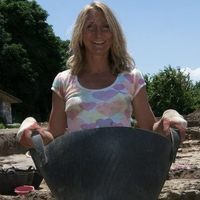Anne Nyquist
University of Oslo, Archaeology, Conservation and History, Department Member
- University of Bergen, AHKR (Archaeology, History, Cultural Studies and Religion), Department Memberadd
- noneedit
Research Interests:
Research Interests:
Research Interests: Ancient History, Applied Mathematics, Archaeology, Archaeological Science, Ancient Religion, and 15 moreArchaeoastronomy, Ancient Greek Religion, Ancient myth and religion, Ancient Greek History, Aegean Archaeology, Antiquity, Apollo, Ancient Greek Architecture, Ancient Greek Mythology, Ancient Architecture, Archaeological Sciences, Archaeological Architecture, Archaeoastronomy SEAC, Archaeoastronomy In Megalithic Culture, and apolllo temples
Research Interests: Genetics, Archaeology, Classical Archaeology, Classics, Art, and 15 moreHistory of Medicine, Late Antique Archaeology, Greek Epigraphy, Funerary Archaeology, Byzantine Studies, Late Antiquity, Hellenistic and Roman Asia Minor, Human Osteology, Funerary Practices, Asia Minor, Hierapolis, Death and Burial Archaeology, Ancient Greek and Roman Necropoleis, Antik Dönem Mezarları, and Burial Practices Archaeology
Research Interests:
Philiskos' gravmonument ligger 5 km nordvest for Nikaia, i landskapet Bithynia (romersk Lille-Asia, dagens Tyrkia). Området er flatt og fruktbart, og i antikken passerte man graven på vei til byen Nikomedeia. Monumentet er delt i to... more
Philiskos' gravmonument ligger 5 km nordvest for Nikaia, i landskapet Bithynia (romersk Lille-Asia, dagens Tyrkia). Området er flatt og fruktbart, og i antikken passerte man graven på vei til byen Nikomedeia. Monumentet er delt i to hovedkomponenter: den nedre delen er formet som en kube. Den virker som sokkel for den øvre delen, som er en monumental, triangulær pyramide.
Research Interests:
Apollonian temples with oracular function related to the cult of Apollo's son Asclepius, as well as, Asclepius temples, (both) appear to align with the heliacal rising of the constellation of the Crow (raven) by the sunrise of the Autumn... more
Apollonian temples with oracular function related to the cult of Apollo's son Asclepius, as well as, Asclepius temples, (both) appear to align with the heliacal rising of the constellation of the Crow (raven) by the sunrise of the Autumn Equinox. Some show to align with Ophiuchus, too. Both constellations are related with the mythological circle of the deities as a dual entity. This astronomical phenomenon is supported by myth, archaeological finds, historical texts, artistic representations and astronomical academic tradition. The seventeen temples-altars chosen for survey cover a major chronological and geographical area. Ten temples are of Apollo and seven are of Asclepius: the Pythios Apollon in Gortyna and associated Lebena Asclepius temple (Crete), the Apollo Maleatas and associated Altar within the Asclepeiion of Epidaurus, and the Asclepius temple of Epidaurus (Peloponnese, mainland Greece), Apollo Deiradiotes and an Asclepius temple close to the town of Argos (Peloponnese, mainland Greece), the temple and oracle of Apollo Clarios and Apollo Temple at Notion (Ionian coast, Asia Minor, Turkey), the Temple of Apollon Lairbenos (Phrygia, Asia Minor, Turkey), the Asclepius Temple, Apollo Kyparissios and an Antonine Apollo temple at the island of Kos, and Asclepius Temple with Apollo Oikos at Messene (southern Peloponnese). Most of the Asclepius Temples (healing centers) are associated with temples (some oracular), altars or worship houses of Apollo. In our analytical work, Apollo and Asclepius function as complementary dualities who corroborate on religious prophecy and healing. On cult sites associated with ceremonial healing and curative practice, the alignment of the temples show the use of star markers in architectural planning: astronomical signs associated with myths of the actual gods, prevail. Through present study, we have shown that intangible and tangible cultural heritage are connected. The astronomical orientation of the temples is studied for their azimuth, angular altitude of the horizon and celestial declination, through applied remote sensing techniques, making use of Google Earth maps and associated astronomical tools.
Research Interests:
Research Interests:
Research Interests:
Research Interests:
Research Interests:
An archaeological presentation of the Solitary obelisk of the north-eastern necropolis of Hierapolis of Phrygia, Turkey.
